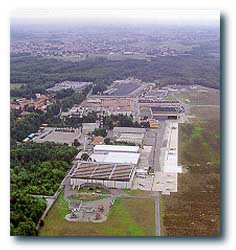
Cascina Costa plan
Agusta can
satisfy the most exacting requirements of civil and military customers
with models that cover all the principal weight categories and which can
be adapted to the requirements of the most wide-ranging missions that can
be carried out by helicopters today. A complete company quality system,
covering every activity from the initial definition of the customer's
requirements through to their fulfilment, guarantees the quality level
required for Agusta products. This result has been made possible by
Agusta's command of all the key technologies necessary for the development
and construction of the modern helicopter: the design and production of
transmissions, rotor heads and blades, structures in metal or composite
material and avionics systems together with the integration of all these
components in a complete "helicopter system". You are invited to
discover for yourselves a patrimony of technology and of human resources
in a story that started almost 100 years ago and which will
continue beyond the year 2000
History
Agusta
has a tradition as long as the history of aviation. Its founder,
Giovanni Agusta, flew his first airplane in 1907 and
from 1923 onwards the company was active in the design, production and
maintenance of fixed wing aircraft at Cascina Costa plant.
Agusta entered the world of vertical flight in 1952 after signing an
agreement with the American company
Bell to produce its helicopters under license. Similar accords were
reached in the ‘60s with the other major US producers: Sikorsky,
Boeing and McDonnell Douglas.
Agusta did not limit itself to
production under licence: starting from this experience, and in a
relatively short time, independent research and development capacity
was created. The numerous projects and the experimental work carried
out at the end of the ‘50s led to the construction of no less than
nine prototypes, all flight tested with success. The innovations
associated with two of these models, the A101G and the A106,
allowed Agusta to enter, as a full member, the restricted club of
companies able to produce independent helicopter designs
Agusta’s place amongst the leaders
in vertical flight was secured with the A109 (commercial and
military) twin turbine helicopter, a design with innovative features
and high performance that was realised entirely at Cascina Costa.
Still in production in the new versions developed later, many hundreds
of its civil, military and public utility variants have been
manufactured: the universal reputation it enjoys is a demonstration of
Agusta’s command of helicopter technological know-how.
A fundamental stage in Agusta’s
development of helicopter technology was reached subsequently in 1983
with the first flight of the A129 Mangusta anti-tank
helicopter, the first attack helicopter to be designed and produced
wholly in Europe, which demonstrated Agusta’s capacity to satisfy the
most complex technical requirements. The success of these models
opened up for Agusta the road of co-operation with other European
helicopter manufacturers in joint defined projects.
In
1981 the design of the EH101 (commercial and military) was
initiated in collaboration with Westland of the U.K., in line with the
requirements of the Italian and British navies. 1985 saw the launch,
in collaboration with the aeronautic industries of France, Germany and
the Netherlands, of the programme for the development of the NH90,
a twin engine multi-role helicopter of 9 tons which will meet the
medium helicopter requirements of these countries’ armed forces.
In 1994 Agusta’s own product range was widened by the introduction of
a new version of A109 denominated A109 Power, in 1995 by the
A129 International and 1997 by the A119 Koala
. In 1998 Agusta signed an agreement with Bell Helicopter creating
a joint venture called Bell/Agusta Aerospace Company for the
development of the AB139 helicopter and the BA609 Tiltrotor, products
that open a new chapter in the company's history
